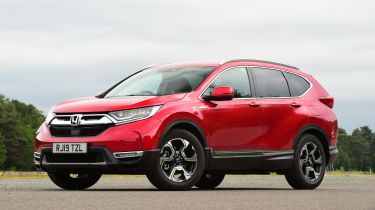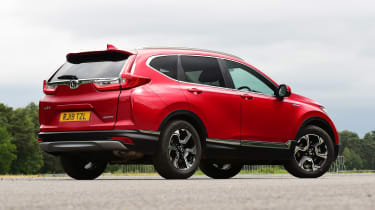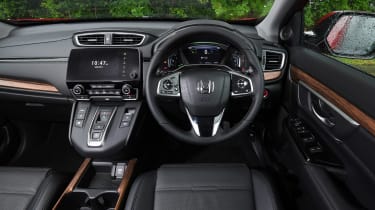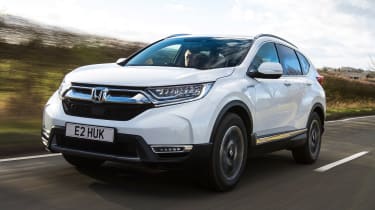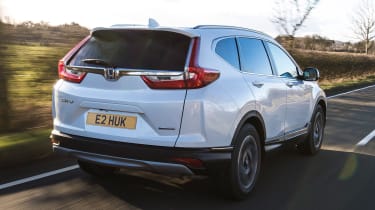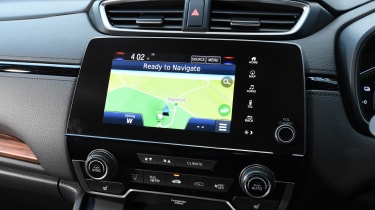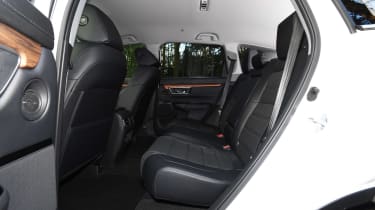Used Honda CR-V (Mk5, 2018-2023) buyer's guide: a fine all-rounder, but it's not cheap
A full used buyer’s guide on the Honda CR-V covering the CR-V Mk5 that’s was on sale in the UK between 2018 and 2023
Verdict
The Honda CR-V Mk5 was replaced by the Mk6 in 2023, but that shouldn’t put you off buying one, as our Driver Power surveys illustrate only too well. Admittedly the CR-V Mk5 is no bargain, but that’s true of any decent car on the second-hand market. And there’s no denying that this Honda crossover is a fine all-rounder that’s easy to live with thanks to its excellent reliability record, roomy interior and user-friendly cabin design. However, the model range isn’t that wide and the CR-V is in a very hotly contested segment, so while we wouldn’t steer you away from the Honda, we suggest that you try one or two alternatives to make sure that you buy the right SUV for your needs.
It’s almost three decades since the original Honda CR-V was unveiled. Launched in 1995, it was Honda’s first in-house SUV, and it was available with an optional boot-mounted shower, but only with a petrol engine. The car proved hugely popular, and Honda built on this success with an all-new CR-V in 2001, which was available with diesel power for the first time.
By the time the fifth-generation CR-V arrived in 2018, it was available with seven seats and a hybrid powertrain. The Mk5 was superseded by a bigger model in 2023, though, leaving the smaller ZR-V to fill the space left by the outgoing CR-V – a car that still has lots to offer, despite its age.
History
The fifth generation of the CR-V went on sale in the UK in November 2018, with a choice of four trim levels, but only one engine: a turbocharged 1.5-litre petrol unit rated at 170bhp. This was available with a choice of front or all-wheel drive, with the latter transmission offered with manual or automatic gearboxes; all front-wheel-drive cars came with a manual gearbox.
Within three months the line-up had been boosted by the addition of a 2.0-litre hybrid powertrain option. This was offered only with an automatic transmission, but once again buyers were able to choose between front and all-wheel drive. From November 2020 the CR-V came in e:HEV hybrid form only, and at the same time the car’s suspension was recalibrated to improve the ride and handling while the bodyshell was strengthened.
Prices
The Honda CR-V is plentiful on the used market, roughly four fifths of which are hybrid editions; the other fifth being 1.5-litre petrol models. You can buy a used Honda CR-V Mk5 for less than £9,000 through our Buy a Car service.
Used - available now
Check the price of a Honda CR-V with our free car valuation tool...
Which one should I buy?
The hybrid isn’t quite as perky as the 1.5 Turbo, but it’s potentially more frugal, depending on your driving style; if you do lots of stop/start driving, it’s likely to reduce your fuel bills. Seven-seaters are ultra-rare, hybrids have a meagre towing limit, and three-quarters of CR-Vs have all-wheel drive, which makes it slightly less economical than the front-wheel-drive alternative.
The entry-level S has 17-inch alloys (18s on the hybrid), automatic LED headlights, climate control and adaptive cruise control. SE trim adds automatic wipers, dual-zone climate control, parking sensors front and rear plus a rear camera and navigation. The SR has leather trim, heated front seats and keyless go, while the EX features 19-inch wheels (18-inch on Hybrid), a panoramic glass roof, heating for the steering wheel and rear seats, plus a powered tailgate.
Alternatives to the Honda CR-V
The enormous popularity of mid-sized SUVs means that most car manufacturers offer at least one. Some of the CR-V’s obvious rivals include the Ford Kuga, Mazda CX-5, Kia Sportage and Hyundai Tucson, while other crossovers that we find easy to recommend are the Peugeot 3008, SEAT Ateca, Toyota RAV4 and Vauxhall Grandland.
All are from mainstream brands, so supply is plentiful, but if you want something more premium, you could consider the hybrid-only Lexus NX, or the ultra-safe Volvo XC60. The Alfa Romeo Stelvio and MG HS are less obvious choices than the likes of the VW Tiguan, Nissan Qashqai, Renault Kadjar and Skoda Karoq. Also think about the BMW X2/X3, Audi Q5 and Mercedes GLC. You’re not short of options in this segment.
What to look for
Spare wheel
Hybrid CR-Vs can’t store a space-saver (unless it’s stashed in the boot, reducing carrying capacity) so they have a tyre-repair kit.
Seats
Front-wheel-drive, hybrid and some AWD CR-Vs had five seats, but the 1.5-litre AWD model was available in seven-seater form – although it’s rare.
Problems
UK-based CR-V forums are very quiet, but some US owners report faulty air-con, and petrol diluting engine oil on 1.5 Turbo models.
Towing
Honda offered two types of factory-fitted towbar: a detachable unit and a retractable one, but the latter couldn’t be fitted to the hybrid.
Common faults
Owners are generally a pretty satisfied bunch when it comes to reliability, but it’s worth keeping an eye out for interiors that have seen hard use – either by families or outdoorsy types, and the like. But it’s a Honda, so well cared-for examples abound.
Interior
Compared with earlier CR-Vs, the fifth-generation model took a significant step up in terms of cabin quality and design, with higher-class materials generally on show. Comfort levels are also high, with excellent seats and plenty of room for five; seven-seaters are quite cramped, but you’re unlikely to find one.
Boot space is excellent for the 1.5 Turbo, at 561 litres (1,756 with the seats folded), but this shrinks to 497/1,697 litres in the hybrid edition.
Running costs
All CR-Vs need to be serviced every 12 months or 12,500 miles, whether they’re powered by the 1.5-litre turbo engine or the 2.0-litre hybrid. There isn’t a huge variation in maintenance costs during the first three years. Once a CR-V has reached its fourth birthday, the service schedule alternates between minor and major.
On top of this, the brake fluid needs to be changed every three years, while the coolant has to be replaced every 10 years or 125,000 miles. If you buy a CR-V that features all-wheel drive, you’ll have to fork out to have the rear differential fluid renewed every eight years. All CR-V engines are chain-driven, so there are no cambelts to replace.
Recalls
Use the official Government online recall checker (gov.uk/check-vehicle-recall) and you might think that the fifth-generation CR-V has been the subject of various recent recalls. In fact, however, most of those notices issued since the arrival of this model have been aimed at older CR-Vs, some of which were made as long ago as 2000.
In reality, since the end of 2018, only one recall has been issued that applies to this CR-V, and that came out in August 2020. The notice affected some CR-Vs built before March 2019, which were fitted with faulty fuel pumps on the production line. This could result in the engine being starved of petrol, which in turn could lead to the engine cutting out or being slow to start. The solution was to fit a new fuel pump.
Driver Power owner satisfaction
The CR-V Mk5 last appeared in our 2021 Driver Power survey, finishing an impressive seventh place. The best scores include top-five finishes for interior quality, safety features, engine and transmission, all-round visibility, rear-seat legroom and brakes. Owners weren't so impressed by the high running costs, or some elements of the dash and switchgear design, though.
Honda CR-V review: what we said
Extracts from our Honda CR-V test drive in July 2022.
A significant number of changes improved the Honda CR-V and its breadth of ability. There’s a sharper driving experience, increased space for passengers and better interior quality compared to its predecessor’s already impressive levels of practicality and reliability.
The lack of a diesel option is becoming less important by the day, although the CR-V's increased price tag may deter some buyers as Honda attempts to move the model upmarket to rival more premium compact SUVs. However, as a complete package, the CR-V is an impressive and highly capable car. It’s perfectly suited to family duties and is highly likely to be satisfying to own, too.
Engines, performance and drive
Honda has made a number of significant changes to the steering and suspension settings of the latest Honda CR-V in order to improve its performance on challenging British roads. Overall, it has pretty much been a success. A quicker steering rack means there are fewer turns from lock-to-lock, giving the CR-V a more reactive and responsive feel when negotiating corners.
Much more emphasis has been placed on ride quality in the latest CR-V, so the suspension is much softer than before. That makes the CR-V significantly better at absorbing lumps and bumps in the road, increasing comfort for passengers. And although the trade-off is an increased amount of body roll in corners, many prospective owners will be happy to make this compromise.
The result of several enhancements throughout the car is that the CR-V offers more driving pleasure and is more comfortable to travel in than before, with high levels of refinement, low noise levels and a smooth ride. The driving position offers an excellent view out too, and although the CR-V is not an exciting car to drive, it’s undemanding, which will be a major plus for many owners.
0-62mph acceleration and top speed
For two years you could buy a CR-V with a 1.5 VTEC turbo petrol engine from the Civic hatchback, where it proves to be usefully powerful and efficient. In the CR-V, the issue is that it has a lot more work to do pulling a bigger and heavier vehicle around, and as a result it spends more time at higher revs. It has the power and torque to give decent acceleration, but the engine needs to be exercised quite hard to do so. The two-wheel-drive manual model can accelerate from 0-62mph in 9.3 seconds and reach 130mph, while the four-wheel-drive version manages 9.8 seconds and 129mph respectively.
The additional power and torque that comes with the CVT automatic gearbox option is welcome here, and in many ways is preferable to the manual because of its more relaxed operation. Demands for maximum acceleration can cause a typical CVT drone as the engine stays at high revs for an extended period. But when driven with restraint, it’s smooth and refined. The four-wheel-drive CVT model accelerates from 0-62mph in 10.0 seconds and can reach 124mph.
The CR-V Hybrid has a completely different set up, using a 2.0-litre petrol engine and an electric motor that also acts as the gearbox. The result is that the Hybrid is the most refined model in the range, with a smooth and quiet operation and a seamless switch between power modes. At low speeds the CR-V Hybrid can operate solely on electric power, while out on the motorway the electric motor cuts in to provide additional acceleration for overtaking. The two-wheel-drive Hybrid CR-V can achieve 0-62mph in 8.8 seconds and reach 112mph, while the four-wheel-drive version performs the same sprint in 9.2 seconds and can reach the same top speed.
MPG and CO2
The previous 1.5 VTEC turbo petrol engine performed well in the Civic hatchback, but dealing with more weight, as well as four-wheel-drive and a CVT transmission in the CR-V, put a drain on its overall efficiency. Fuel economy was rated at between 32.5 and 38.2mpg depending on model, meaning it was far from the most efficient petrol SUV. It’s no longer sold new, despite being reasonably popular.
The CR-V Hybrid performs better, although a WLTP-verified best of 42.8mpg for the 2WD model and 39.8mpg for the four-wheel-drive model isn’t a patch on the most efficient diesels. It is important to note however that official consumption tests work in favour of hybrid vehicles as they allow some of the low-speed running to take place solely on battery power, something which could only happen for a limited distance when used in the real world.
The CR-V Hybrid had previously offered much lower Benefit-in-Kind tax for company car drivers, but its emissions are no longer around 120g/km under the WLTP testing regime; even the most efficient model puts out 151g/km of CO2, rising to 163g/km for top-spec four-wheel drive versions. All models therefore occupy quite high Benefit-in-Kind (BiK) tax bands.
Honda doesn’t give an official figure for the range of the Hybrid version on electric power only, but a battery capacity of 1kWh is relatively small compared to rivals such as the Toyota RAV4, so this range is likely to be quite limited. Really the electric motor is there to supplement the petrol engine, rather than power the CR-V along by itself. The CR-V Hybrid charges its battery by energy regeneration or via the petrol engine, so cannot be charged by plugging into a charging point.
Interior design and technology
Honda clearly felt that the previous generation CR-V had the right kind of exterior style because the new generation model is very similar in appearance. There are flashes of chrome around the nose and large alloy wheels as standard on higher specification models, but ultimately this is a safe and sensible design. It’s unlikely to win the hearts of buyers, but at the same time it won’t put many off, either.
Inside there are more significant changes, and the CR-V benefits from a push upmarket with improvements to the materials used and the layout of the controls. Choose a top-specification EX model and the cabin is finished in high-quality leather and wood, and although some of the lower sections still use less appealing plastics the overall effect is pleasing to look at and to touch.
The layout of the CR-V’s dashboard is sensible and convenient, with a high-set central spar putting the major controls close to the wheel, including the manual or automatic gearlever where fitted. It also leaves plenty of space beneath the centre console and gives the driver the sense of being in command of the car. A digital instrument display is fitted as standard and gives the driver plenty of options to display the required information, while a head-up display system is also available as an option.
Sat-nav, stereo and infotainment
Another useful improvement on the new generation CR-V is an updated infotainment screen, which is seven inches in size and is better integrated into the dashboard than in the previous model. The system itself, however, remains occasionally frustrating, as simple tasks can sometimes prove difficult to complete.
Mitigating this is the fact that the system now has a rotary controller to change the volume and separate controls for the climate control system, while Apple CarPlay and Android Auto come as standard on SE models and above. The CR-V’s in-built Garmin navigation system is also quite dated, with very simple graphics and sometimes sluggish responses. It’s not really in keeping with the quality of the car elsewhere.
Practicality, comfort and boot space
The driving position in the fifth-generation CR-V is one of the best aspects of the car’s interior, with plenty of adjustment in the seats and steering wheel combined with an uncluttered view through the windscreen, while the view out is also good for passengers in the rear seats. There are plenty of storage areas in the cabin, in particular, the centre console offers an adaptable amount of space by offering the facility to slide forwards and backwards.
Size
The CR-V is significantly longer than both the Volkswagen Tiguan and Peugeot 3008 and only a fraction shorter than the Land Rover Discovery Sport. That makes it one of the largest vehicles in the segment and contributes to the impressive amount of interior space. Compared with these vehicles, the CR-V is both taller and wider than all but the Discovery Sport, again illustrating an impressive level of space efficiency.
Leg room, head room & passenger space
Occupants of the first and second rows in the CR-V enjoy excellent head and legroom, and a great deal of attention has clearly been paid to maximise comfort and space for passengers. For example, the transmission tunnel has been made as slim as possible to ensure minimal intrusion into legroom for the rear passenger in the middle seat. A third row of seats is no longer available with the Hybrid model.
Boot
Due to the latest CR-V’s design, the boot V is fractionally smaller than the previous generation model’s. It still offers a substantial 497 litres, though, which is more than in the Nissan Qashqai but less than in the Volkswagen Tiguan and Land Rover Discovery Sport. An electric tailgate is standard only on the top specification EX models, but the boot itself has a relatively low loading lip for an SUV and a broad opening.
Folding the seats is also easy, with a single strap for the third row and convenient levers located in the boot for row two. Honda’s Magic Seat design means the second row folds flat into the floor automatically too. With the rear seats folded, the CR-V offers up to 1,692 litres of space.
Come and join our WhatsApp channel for the latest car news and reviews...

